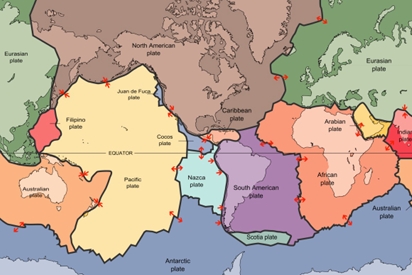lab plate tectonics
1/9
There's no tags or description
Looks like no tags are added yet.
Name | Mastery | Learn | Test | Matching | Spaced |
|---|
No study sessions yet.
10 Terms

Describe what is shown in this picture
plate boundaries, arrows pointing outward are divergent boundaries, arrows pointing at each other are convergent boundaries and arrows parallel are transform fault boundaries.
what is ocean bathymetry
The study of the depths of different areas of the ocean
what is the relationship between plate boundaries and earthquakes
Earthquakes are the result of stress from plates sliding past each other at their boundaries or where they collide.
explain how different types of earthquakes are related to plate boundaries
Mid ocean ridges and transform faults produce shallow quakes, collision zones produce shallow to intermediate, and subduction zones produce shallow, intermediate, and deep. des
Describe the pattern of magnetization on the ocean floor by a mid ocean ridge.
it is magnetized in alternating strips, which is caused by magnetic sediment being drawn a certain way depending on the earths poles, which undergo reversal every ~200,000 years
what are polar reversals
the reversal of the Earth’s poles due to molten iron in the outer core, occurs once every ~200,000-300,000 years.
how can magnetic reversals help us determine spreading rates and plate velocities
By measuring the magnetic strip’s width, it can help determine the time since the last reversal. this also allows to see how quickly the strip itself grew, showing plate velocity’s.